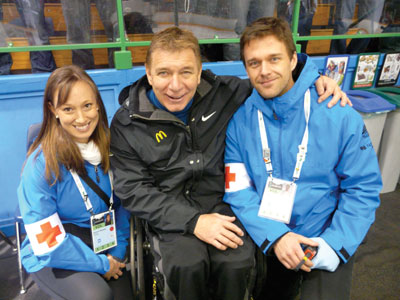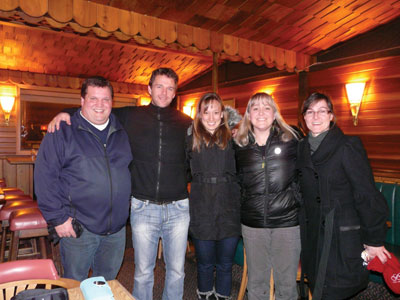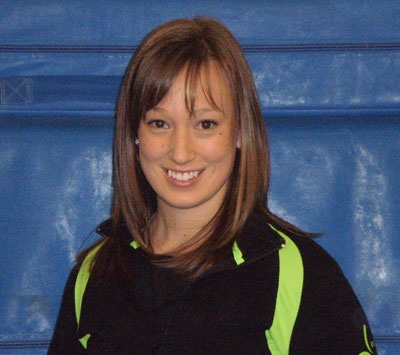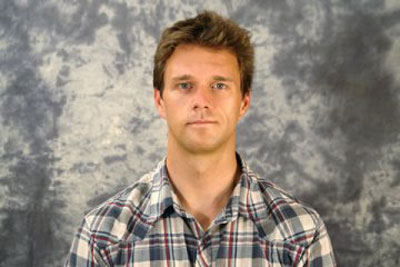
From March 4-10, 2012, the Arctic Winter Games (AWG) took place in Whitehorse, Yukon.
From March 4-10, 2012, the Arctic Winter Games (AWG) took place in Whitehorse, Yukon. The AWG is a very unique competition; it is an international, circumpolar event that provides opportunity for developing athletes to compete while sharing cultural values from northern regions around the world.
 |
|
| Dr. Brynne Stainsby and Dr. Steven Piper with Rick Hansen at the 2012 Arctic Winter Games gold medal hockey game. Advertisement
|
The Dene Games – a component of the AWG – are particularly distinctive and participation often forms an important part of the athlete’s cultural identity. For example, one Dene athlete who was assessed this year was reported as tearing his anterior cruciate ligament (ACL) nine years ago. He had continued to compete without assessment or treatment for almost a decade because of the importance of these Games to his community. Historically, these games helped the Dene people prepare for hunting and fishing, and were also the entertainment for these trips. Presently, the Dene Games allow other athletes to learn about this culture by observing and participating in events such as the finger pull, ear pull, knuckle jumps and
sledge jumps.
The Interdisciplinary Medical Team
As volunteer chiropractors on the medical team, we assessed and triaged athletes at high-risk venues such as hockey, gymnastics and the Dene Games. Our experience working with the medical team was incredible and the efficiency and organization of the medical staff must be commended. Qualified personnel, the Games and Events Management (GEMS) reporting system, a dedicated transport system and the multidisciplinary polyclinic ensured the safety and care of the 2000 athletes.
As chiropractors and first responders, we worked alongside health professionals to assess and triage musculoskeletal injuries and we referred to our colleagues for medical conditions. It was an excellent example of multidisciplinary teamwork to provide appropriate care for the athletes.
Cultural Learning Experience
In addition to our experiences working with the medical team and athletes, we had the fantastic opportunity to learn about the unique culture in northern communities. We were very fortunate to receive VIP tickets from the Chair of the Medical Committee to attend the Cultural Gala. This was a fantastic event where young performers showcase traditional songs and dances from their countries or regions. It was one of the highlights of the Games, and truly demonstrated the AWG vision of being an international celebration of northern sport, culture and friendship. After attending the Gala, we realized that the AWG was more than just a competition; it was an opportunity to recognize and celebrate the role of sport and culture in northern communities. We felt extremely lucky to be a part of it.
We were also very fortunate to live within the community during our time there and were hosted by a gracious volunteer and paramedic. To make sure we truly experienced the “Yukon’er life,” he was kind enough to take us ice fishing on our last day in Whitehorse – this was a truly northern experience!
Conducting a Study
We wanted to truly maximize our experience at these Games and, so, we conducted a study in conjunction with our volunteer work on the medical team. As chiropractors and health providers, we were interested in examining the impact that participation in the 2012 AWG may have on the athletes’ health behaviours.
 |
|
| Dr. Brynne Stainsby (middle) and Dr. Steven Piper (second left) with Patrick Ross, Whitehorse, Yukon, city planner (far left), Lisa Ross, Medical Chair of 2012 Arctic Winter Games (second right) and local chiropractor Dr. Melanie Lachapelle (far right).
|
Physical inactivity as well as a lack of access to, and a resulting decrease in, consumption of nutritious food choices have been well documented as significant barriers to health in northern and rural communities.1,2 As we expected that athletes would be more active than the general population, our study aimed to document the activity level of athletes relative to the general population, and further determine if athleticism was reflected in other behavioural differences such as increased consumption of fruits and vegetables.
We are very fortunate to be collaborating with Dr. Samuel Lankford from the University of Northern Iowa for this study. Dr. Lankford has been collecting data for the AWG International Committee over the past 15 years, conducting research on the economic and social impact of the AWG on northern communities.
His data has been instrumental in documenting social benefits of the Games to athletes and their communities, and ensuring that the Games continue to exist. We are hopeful that our research will be able to support his findings and encourage innovative strategies to maximize the health of these northern athletes and their communities.
We gratefully acknowledge the Canadian Memorial Chiropractic College for their support of this study. Without their assistance, we would not have been able to experience the AWG and complete this research. We are excited to move into the data analysis phase of our study to determine the results, and look forward to future collaborations with Dr. Lankford and the AWG International Committee.
Finally, the 2012 AWG provided us the opportunity to experience international circumpolar and northern Canadian cultural and hospitality at its best. The generosity of everyone involved was humbling, from a welcoming smile and educational conversation on circumpolar cultures from a volunteer; to insight into training and northern sport from an athlete or coach; to a one-on-one conversation regarding chiropractic care with Rick Hansen. We feel extremely fortunate to have had the opportunity to participate, and are so proud to have represented the chiropractic profession and our country on the medical team.
We look forward to the 2014 AWG in Fairbanks, Alaska!
References
Van der Woerd K, Swift K, Rogers B, Tsuruda S. Literature synthesis and an-notated bibliography of barriers to healthy eating, physical activity and active transportation in the north. CAPTURE. 2011 Dec. 7:1–32.
Kirby AM, Levesque L, Wabano V, Robertson-Wilson J. Perceived community environment and physical activity involvement in a northern-rural Aboriginal community. Int J Behav Nutr Phys Act. 2007;4(1):63–63.

|
Brynne Stainsby BA, DC, practises at Advantage4Athletes in Markham, Ontario, and is a faculty member at the Canadian Memorial Chiropractic College (CMCC) in Toronto. Upon graduating in 2009 from the Doctor of Chiropractic program summa cum laude, Dr. Stainsby completed a graduate studies residency in Clinical Sciences in July 2011 and is preparing to complete the Fellowship exam for College of Chiropractic Sciences (Canada).
 |
Dr. Steven Piper graduated in 2011 from the Doctor of Chiropractic degree program at the Canadian Memorial Chiropractic College (CMCC) in Toronto. He is currently enrolled in the two-year postgraduate Sports Sciences Residency program at CMCC with aspirations of becoming a fellow of the Royal College of Chiropractic Sports Sciences (Canada).
Print this page